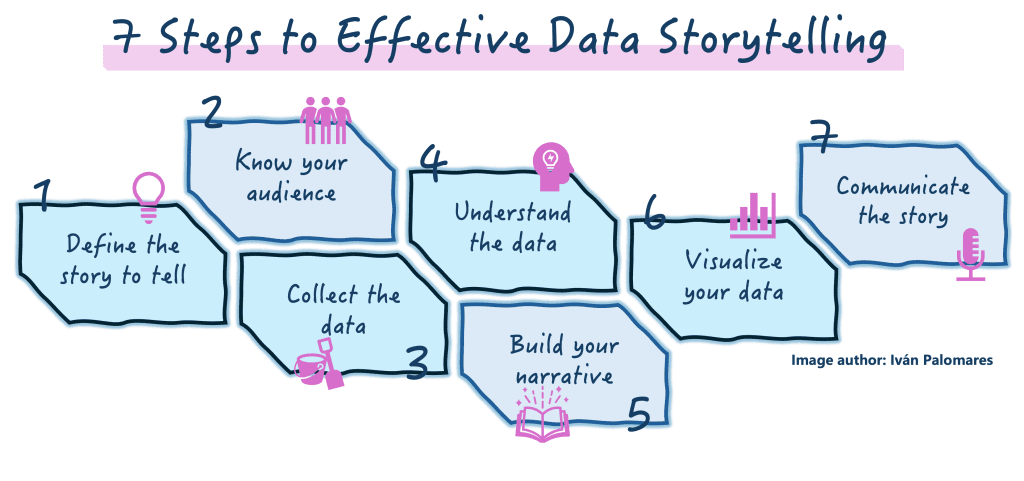Image by the author | Midjourney and Freepik
If data can be leveraged to create informative visual representations, why not use it to articulate and communicate a story? This tutorial highlights the importance of data storytelling and explains how to become a skilled data storyteller through seven steps.
Data storytelling It is the art and process of effectively leveraging data to tell a story that communicates information and insights to a specific audience. It is a valuable tool for communicating the results of data analysis, making data-driven insights accessible to a broader audience, or disseminating data in a more engaging way.
There is no one way to tell stories with data, but the following steps provide a recipe that, if followed sequentially, will maximize your chances of successfully telling an insightful, interesting, and compelling story around your data.


Image by the author
Step 1: Define the story you want to tell
This step lays the foundation for a compelling data story. Start by determining the key message that will be conveyed through your data. Identify the key insights you want your audience to understand and a clear direction to get to them.
Let’s say you’re analyzing sales data for a fashion retail company. The intent of your article could be defined as showing seasonal trends and highlighting peak periods. This clear definition will help you extract insights into how different seasons affect sales and develop marketing strategies accordingly.
Step 2: Know your audience
Understanding who your audience is and what their background, interests, and motivations are for listening to you is essential to creating a compelling data story tailored to them.
For example, in the case of fashion retail, your audience may include the company’s executive and marketing departments, who need sales insights to optimize promotional campaigns and stock inventory. This profiling exercise helps you determine the right actionable insights and tailor the language used around the data to make it relevant and accessible to decision makers.
Step 3: Collect the right data
Make sure you collect the data needed for your story accurately and completely, capturing all the details needed to fit your goals and support your narrative. The data collected should be relevant, reliable, and sufficient to support your key message.
Gathering sales data from the past four years, categorized by season, product category and location, could help find revealing sales patterns and thus support the intended narrative.
Step 4: Understanding the data
Analyze the collected data to reveal trends, such as sales spikes during the holidays or spikes in beachwear sales at the beginning of summer. Identify anomalies such as unexpected sales drops and compare monthly sales over the years. This analytical process is vital for highlighting critical information, for example, to discover the best times to launch certain promotional campaigns.
Step 5: Build your narrative
Did your analysis reveal interesting data about seasonal sales trends? Then it’s time to craft a strong narrative around them. This is a critical step where you are strongly encouraged to tick a few boxes to structure an engaging and informative story:
- Provide context by highlighting important facts underlying the data, for example, describing the importance of understanding fluctuations in sales.
- Highlight key elements or actors involved in the phenomena described, such as best-selling products and stores.
- Describe the challenge encountered – for example, inconsistent monthly sales or unexpected declines – and propose solutions such as targeted campaigns during critical periods.
Step 6: Visualize your data
A proper data story cannot be presented without visual support through data visualizations. Identify the appropriate chart types to visualize facts or properties related to your data: line charts to show sales trends over time, bar charts to compare sales across product categories, or heat maps to pinpoint top-selling locations.
Visuals are the lifeblood of a data story – they make complex data easily understandable and positively impact your audience by helping them understand the key insights you intend to convey.
Step 7: Communicate the story to your audience
Finally, it's time to present your data story to your audience, through a comprehensive report and an interactive dashboard containing the visualizations made in step 6.
Remember to revisit step 2 here (know your audience) and use clear, concise language, tailoring your presentations to their needs and emphasizing practical knowledge.
In the realm of fashion retail, you may want to conclude by outlining strategies for taking advantage of peak sales periods and addressing unexpected sales dips. This way, your audience will leave the room feeling empowered to improve their marketing and sales strategy efforts based on the insights you’ve just provided them.
Ending
By implementing these seven steps to create a compelling data story, you’ll be able to turn raw data into insightful stories that drive engagement, empower your audience to make informed decisions, and ultimately lead to successful outcomes.
Ivan Palomares Carrascosa is a leader, writer, speaker, and advisor on ai, machine learning, deep learning, and law. He trains and guides others to leverage ai in the real world.






